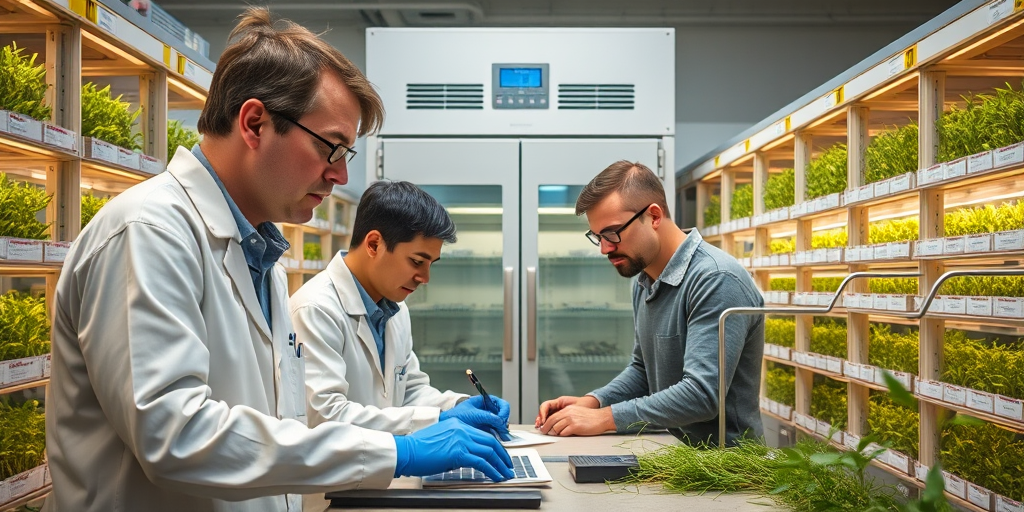Preserving Genetic Diversity of Soybeans for a Resilient Future
In the heart of the University of Illinois Urbana-Champaign, nestled within a vast walk-in refrigerator, lies the beating heart of global food security—the National Soybean Germplasm Collection. This repository is not merely a seed bank; it is a genetic library that holds nearly 23,000 soybean varieties, underscoring its pivotal role in ensuring a resilient future for one of the world’s most crucial crops.
A Rich Repository of Genetic Potential
The National Soybean Germplasm Collection is the United States’ only public soybean seed bank. Managed by the USDA Agricultural Research Service (ARS), this extensive collection represents the cornerstone of soybean breeding innovation, impacting both domestic and global agricultural practices. As agricultural challenges evolve with emerging diseases and shifting climates, the collection’s significance becomes increasingly evident. Soybeans, a staple crop in the United States, face new threats such as red crown rot. Fortunately, the genetic diversity preserved within the collection provides researchers the material they need to develop robust, pest and disease-resistant strains.
“Most varieties grown in Illinois have resistance to soybean cyst nematode thanks to the collection,” states Brian Diers, an emeritus professor and soybean breeder from the University of Illinois’ Department of Crop Sciences. “Without that resistance, it’d be hard to grow soybeans profitably.”
Local Impact and Community Engagement
For the community surrounding Urbana, Illinois, the presence of the National Soybean Germplasm Collection represents more than a scientific endeavor—it symbolizes a promise for sustainable agricultural prosperity. Local farmers, like Brandon Laue, acknowledge its critical role, stating, “It’s an invisible foundation that’s quietly shaped the success of farms like mine for decades—and it’s just as critical to our future.”
The collection predominantly focuses on soybean maturity groups III through V, which are most suitable for Illinois’ climate, directly benefiting the state’s 43,000 soybean farmers. “Having that vast collection so accessible to U. of I. researchers directly benefits Illinois farmers,” says Abigail Peterson, director of agronomy for the Illinois Soybean Association.
Challenges and Opportunities
Maintaining this genetic diversity is no simple feat. Once collected, seeds are stored nearly at freezing temperatures to ensure viability over a decade. Every ten years, 10% of the seeds are cultivated to replenish the collection—a rigorous process that tests even the most advanced agricultural techniques.
“It’s critically important to maintain this collection, because if it were lost, we would never be able to recover it,” Diers emphasizes. The collection’s infrastructure, including a newly-installed $300,000 seed vault and comprehensive maintenance funds, ensures its durability, but replicating it elsewhere would cost a staggering $2.5 million.
Dr. Adam Davis, head of the Department of Crop Sciences at ACES, echoes these sentiments, emphasizing the collection’s vital role supported by robust infrastructure and strategic collaboration with key organizations such as the Illinois Soybean Association.
Strategic and Economic Significance
Beyond local boundaries, the collection’s impact on global food security cannot be overstated. For instance, it provides resistance to diseases like soybean rust in Sub-Saharan Africa, contributing to its agricultural resilience. Moreover, as consumer preferences evolve towards higher protein and healthier oil profiles, the collection’s genetic diversity enables advancements in soybean oil composition, enhancing both nutritional and market value.
The economic ramifications are substantial. Exports of soy-derived products are crucial to the U.S. agricultural economy, and sustaining robust, disease-resistant strains helps ensure competitive advantage. “Whether it’s combating a new disease or improving oil quality, the germplasm collection is an invaluable resource,” Peterson asserts, indicating its role as an essential tool in the industry’s strategic growth.
Looking to the Future
As the agricultural landscape continues to change with threats on the horizon, including climate shifts and new diseases, investment in genetic preservation becomes crucial. Bob Reiter, a former head of research and development in Bayer’s crop sciences division, notes, “There are always going to be instances where we will need to have access to this germplasm—the most prominent being new diseases or insect pests.”
Looking ahead, the collection maintains its mission to empower future scientific innovations that safeguard soybean agriculture. Efforts are already underway to address the evolving threat of soybean cyst nematodes, highlighting the collection’s continued relevance and adaptability.
Resources for the Community
Recognizing the significance of this collection to local and global food systems, stakeholders are committed to transparency and public engagement. Residents and researchers can access information through platforms such as Morning Ag Clips, which offers resources and updates on agricultural developments directly pertinent to the community’s interests.
With the stakes so high, the National Soybean Germplasm Collection stands as a testament to proactive conservation and forward-thinking agricultural strategy. It represents not only a safeguard for food security but also a beacon of hope for a resilient agricultural future.
In conclusion, the preservation efforts at the National Soybean Germplasm Collection emphasize the critical need for genetic diversity in confronting agricultural challenges. By safeguarding this diversity, the community of Urbana contributes to a broader initiative that ensures soybeans remain a staple of the global diet, adaptable and resilient to the challenges of tomorrow.







